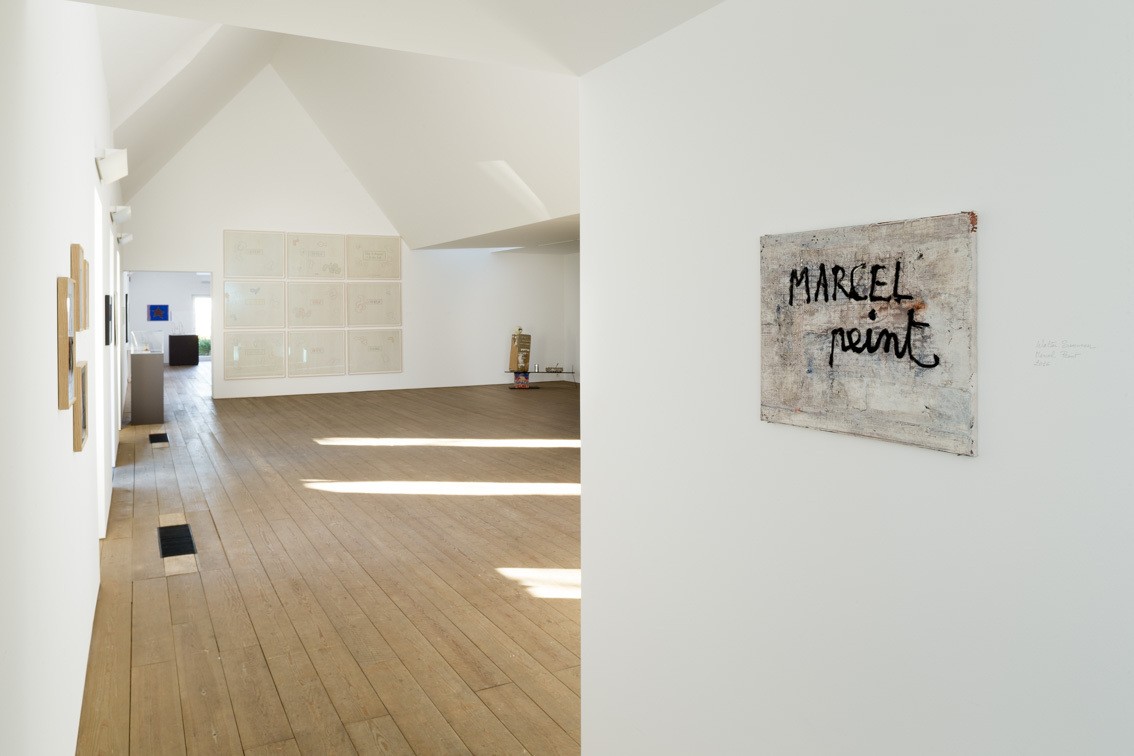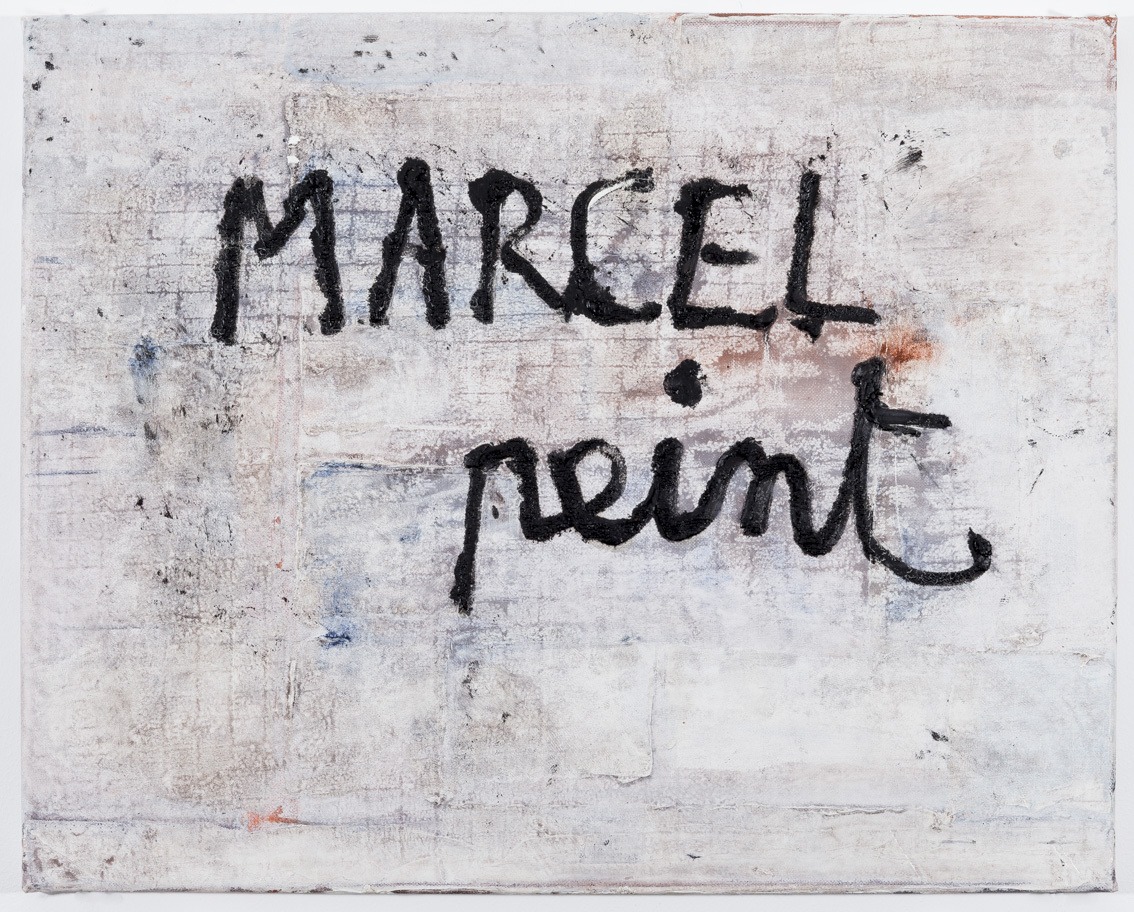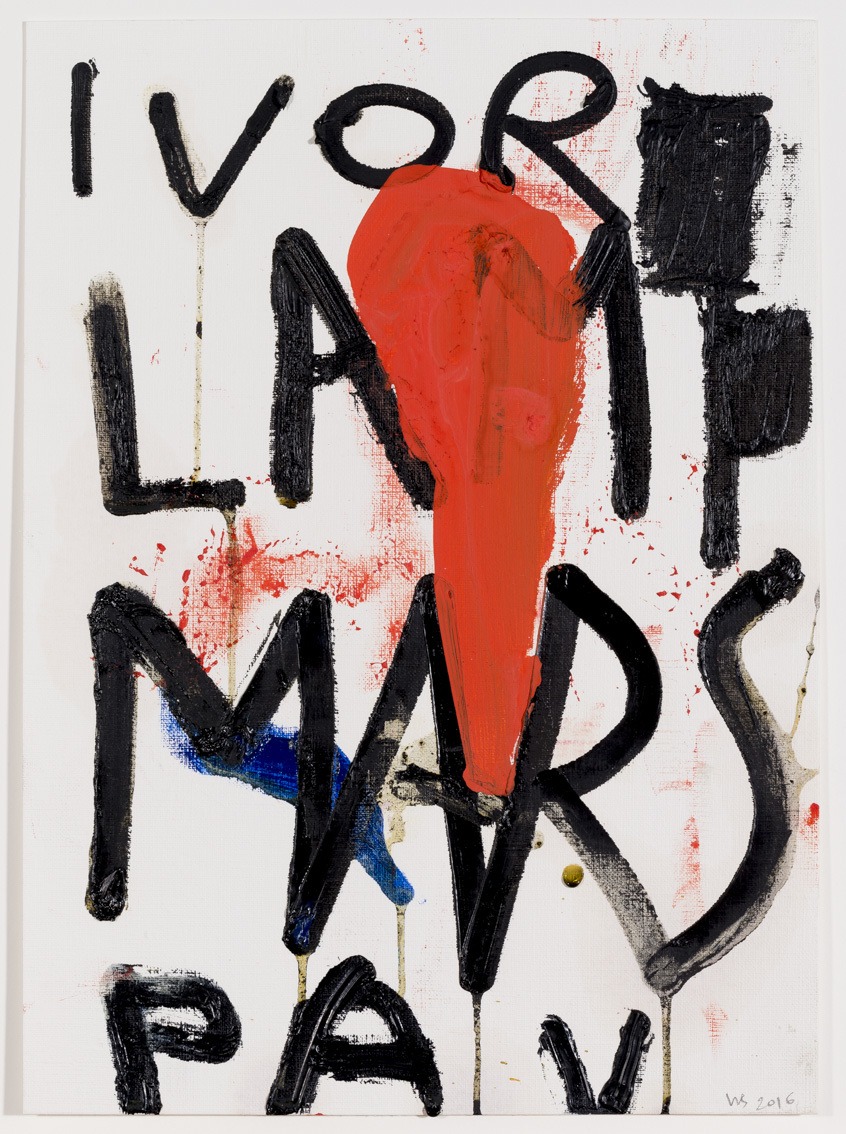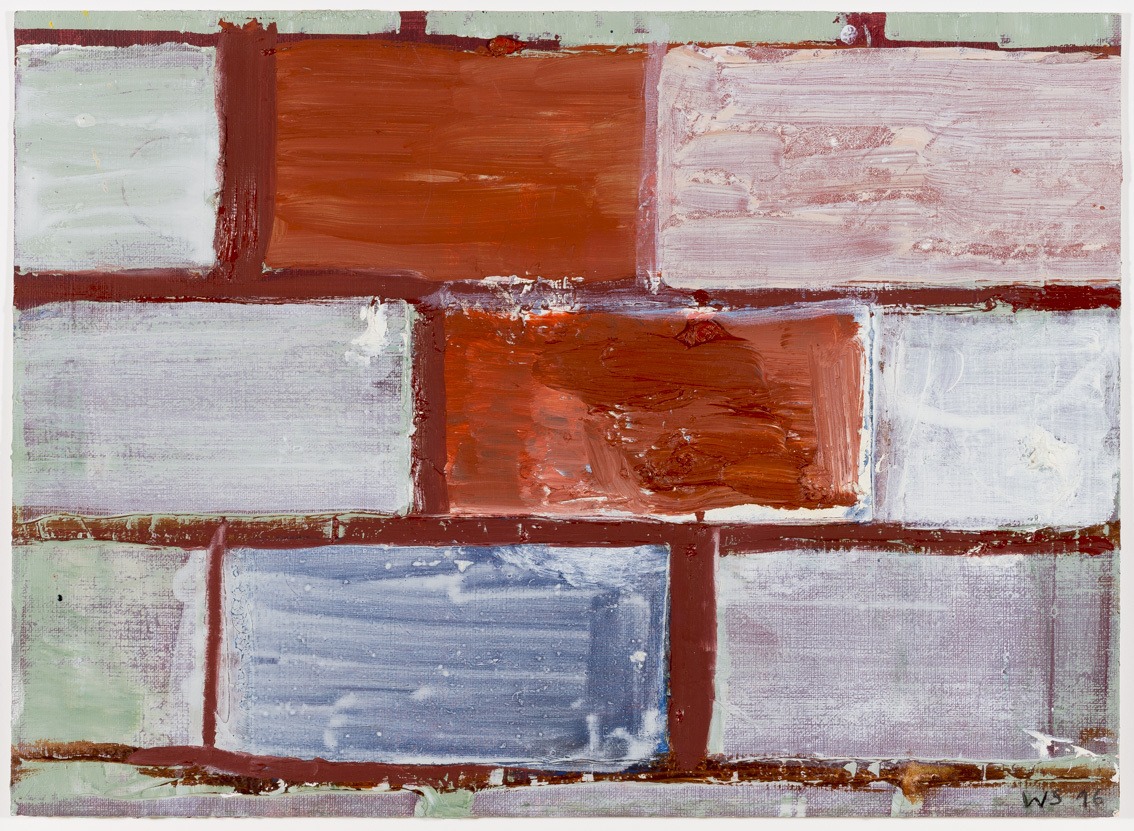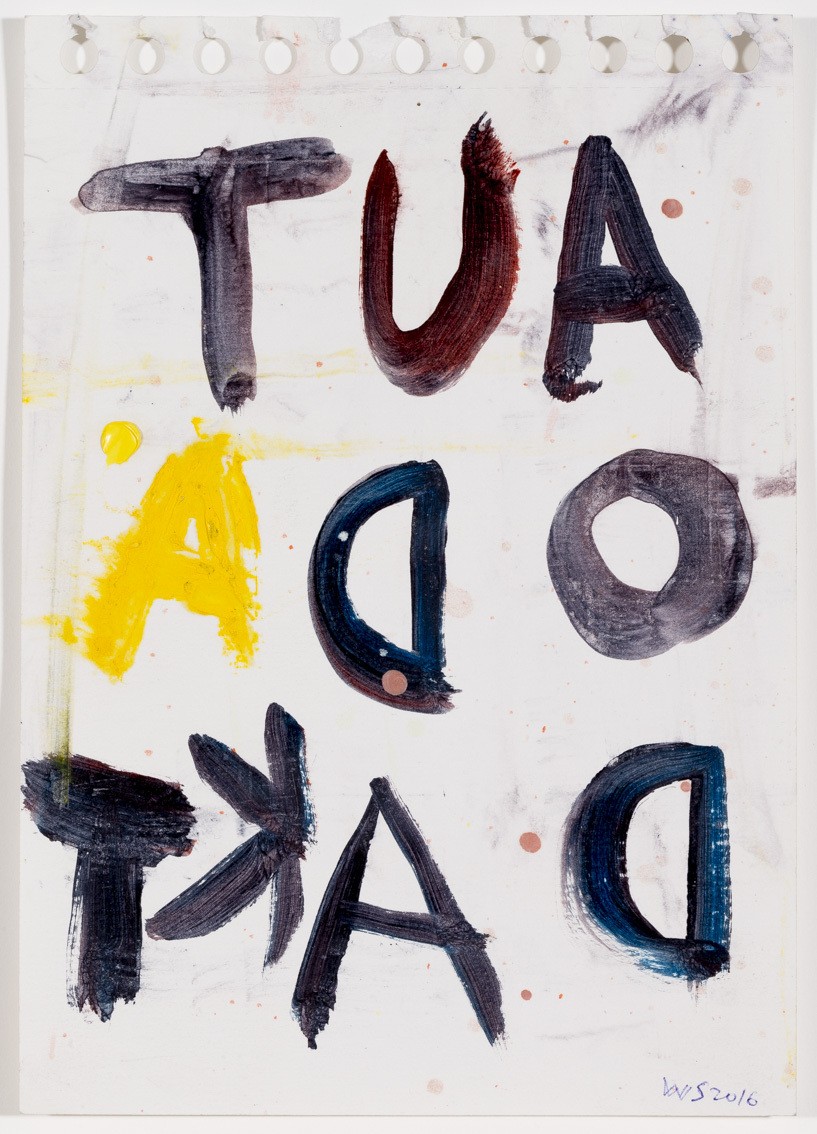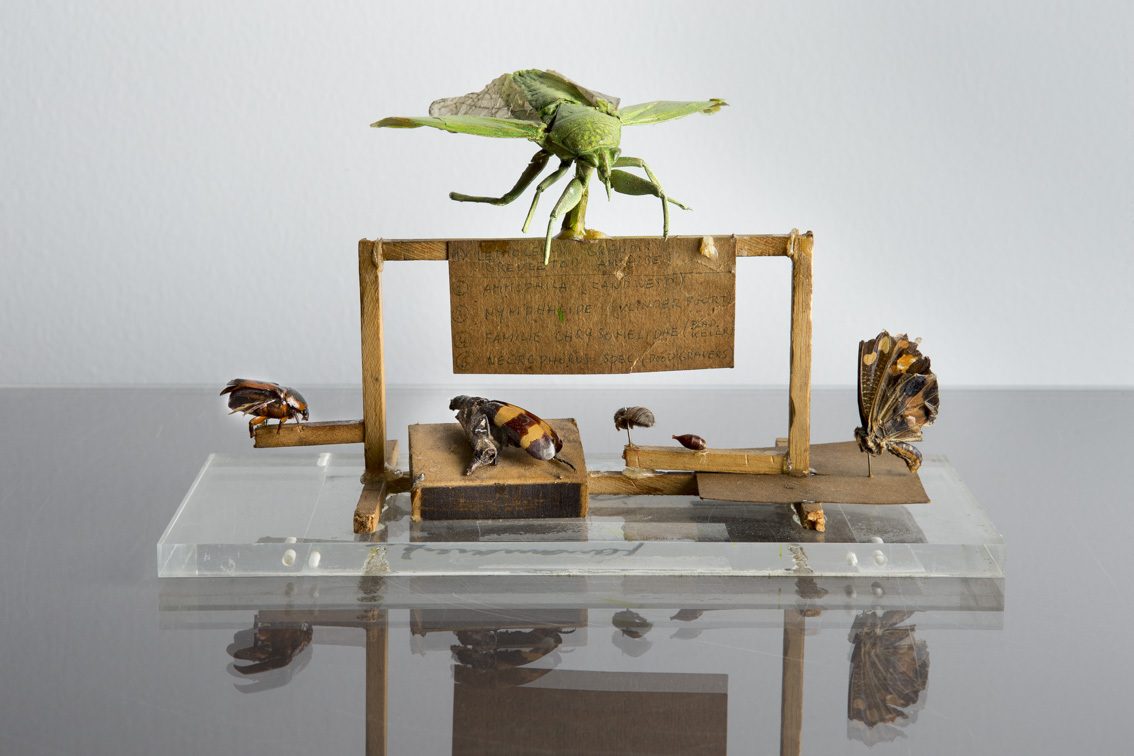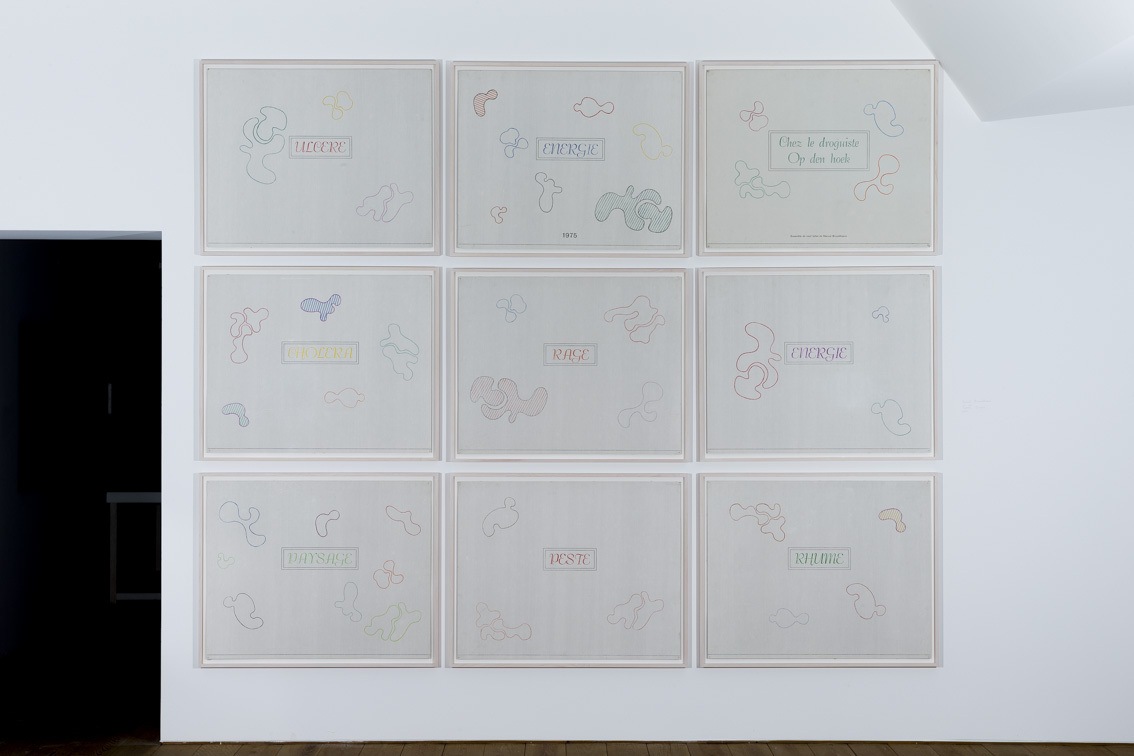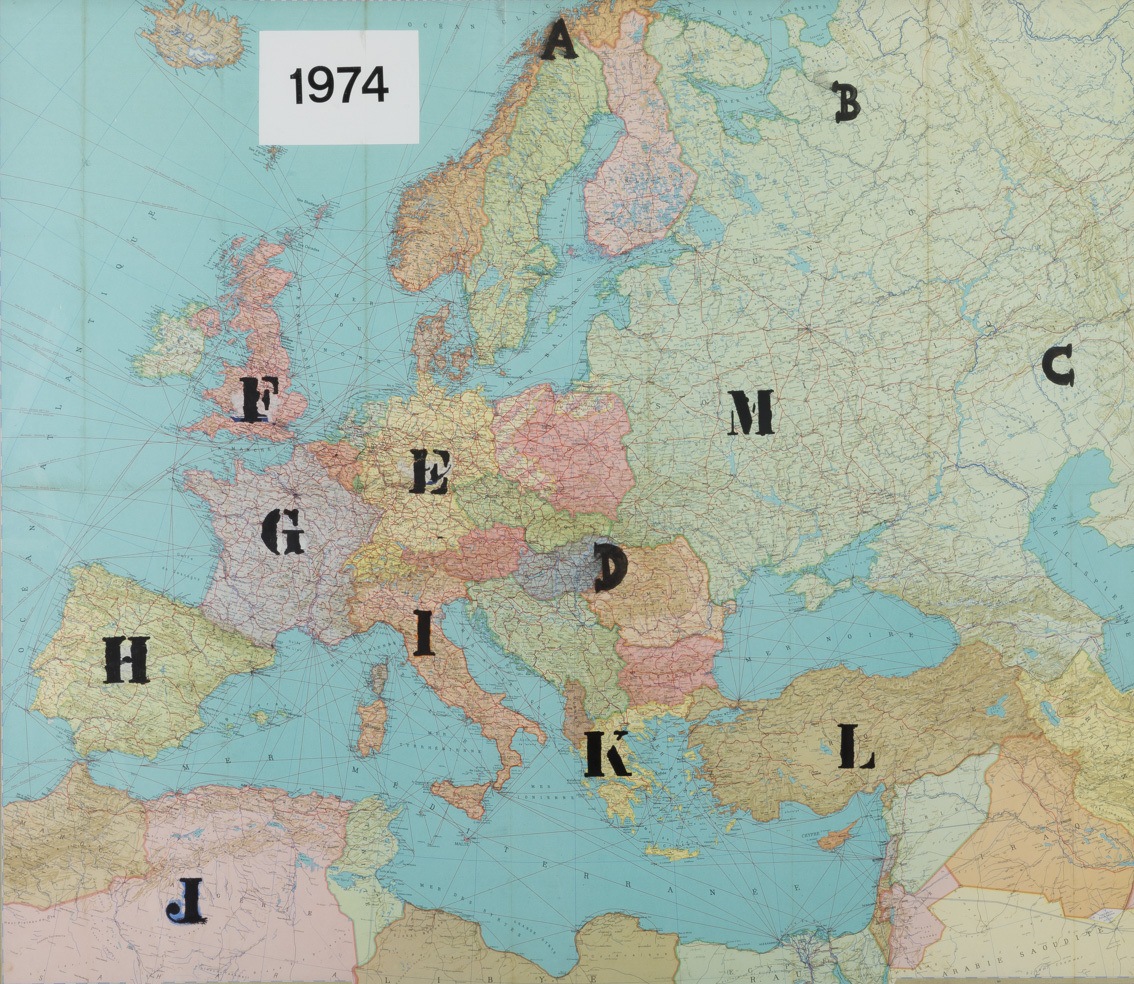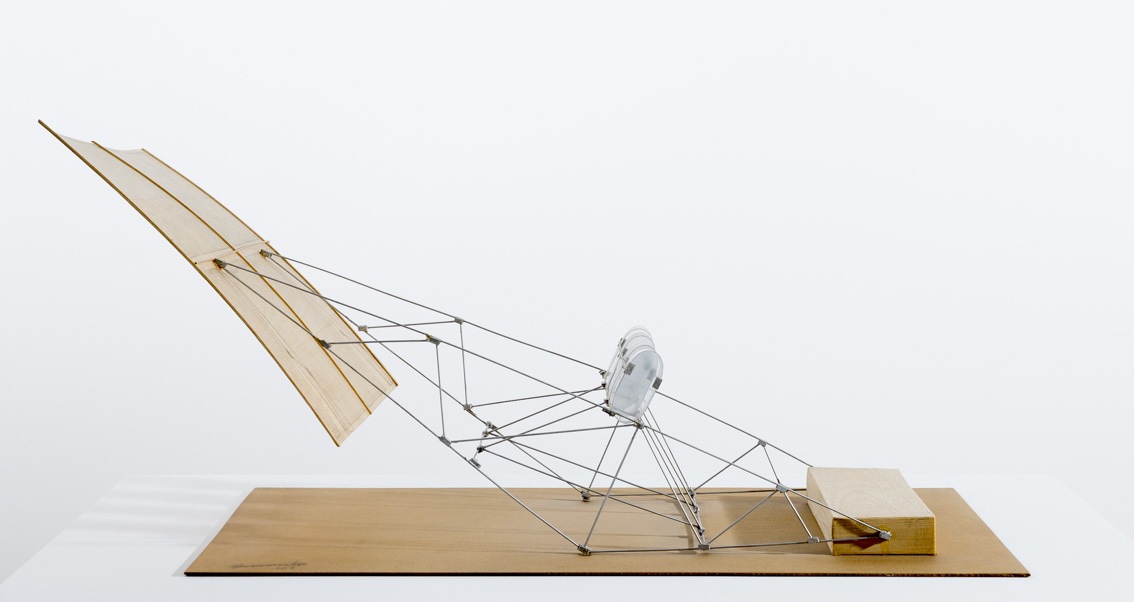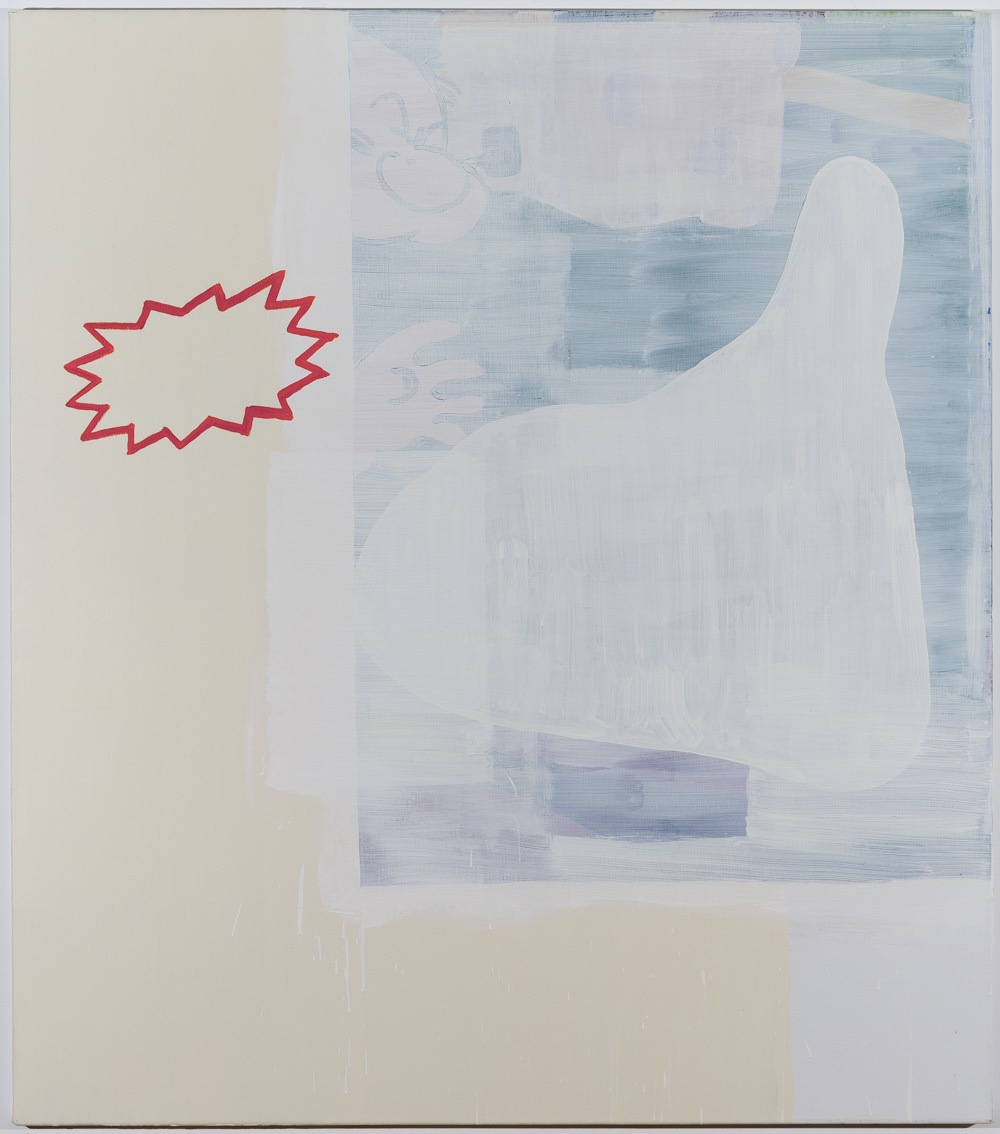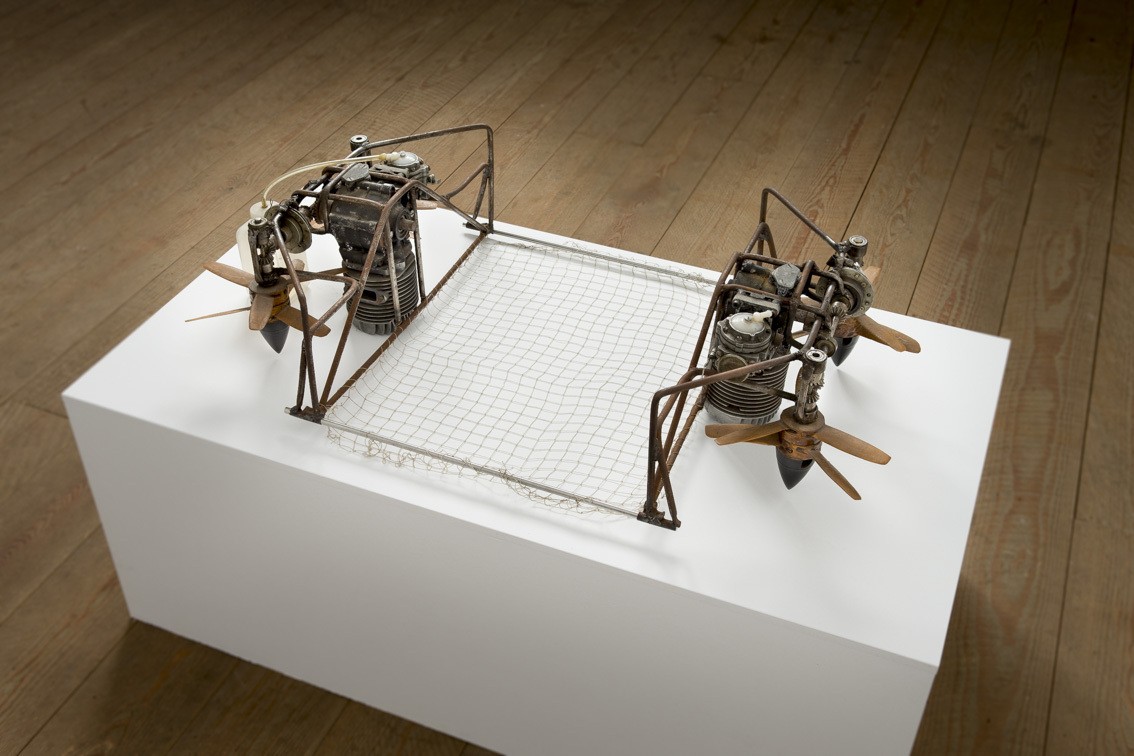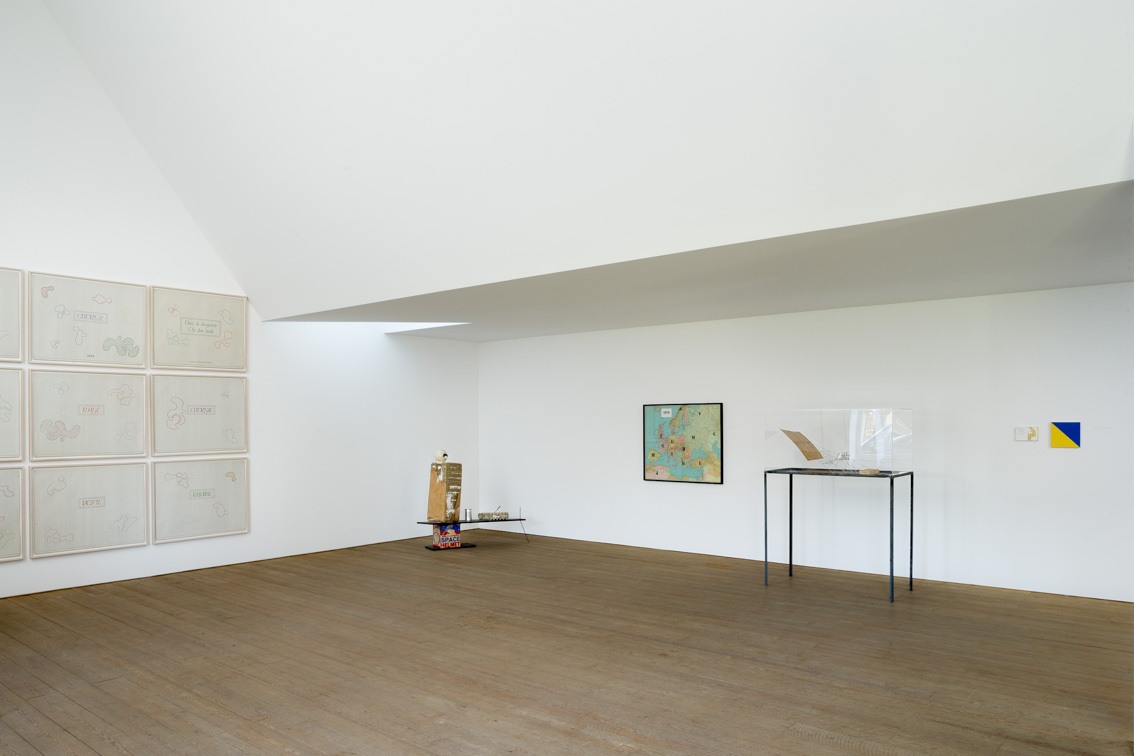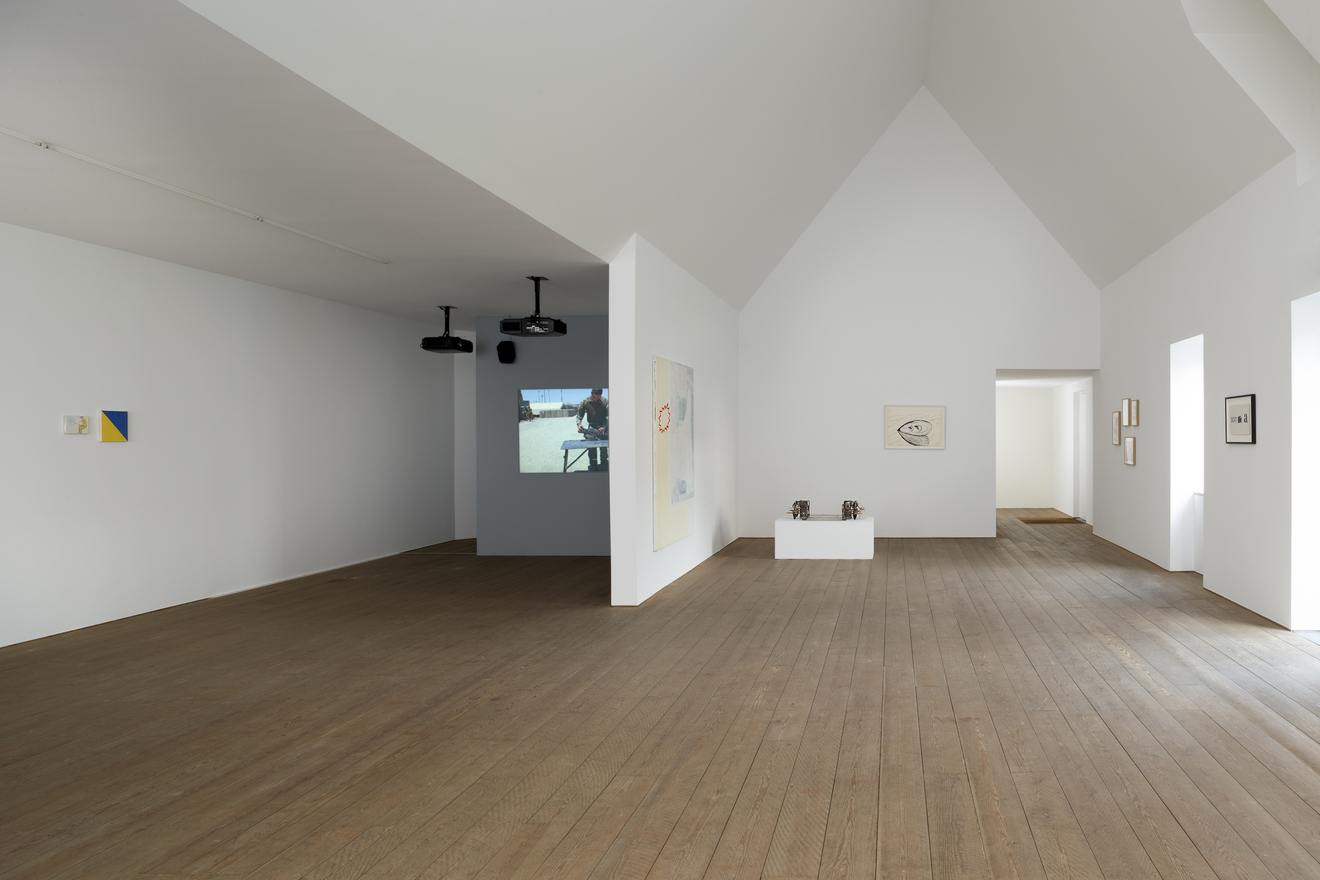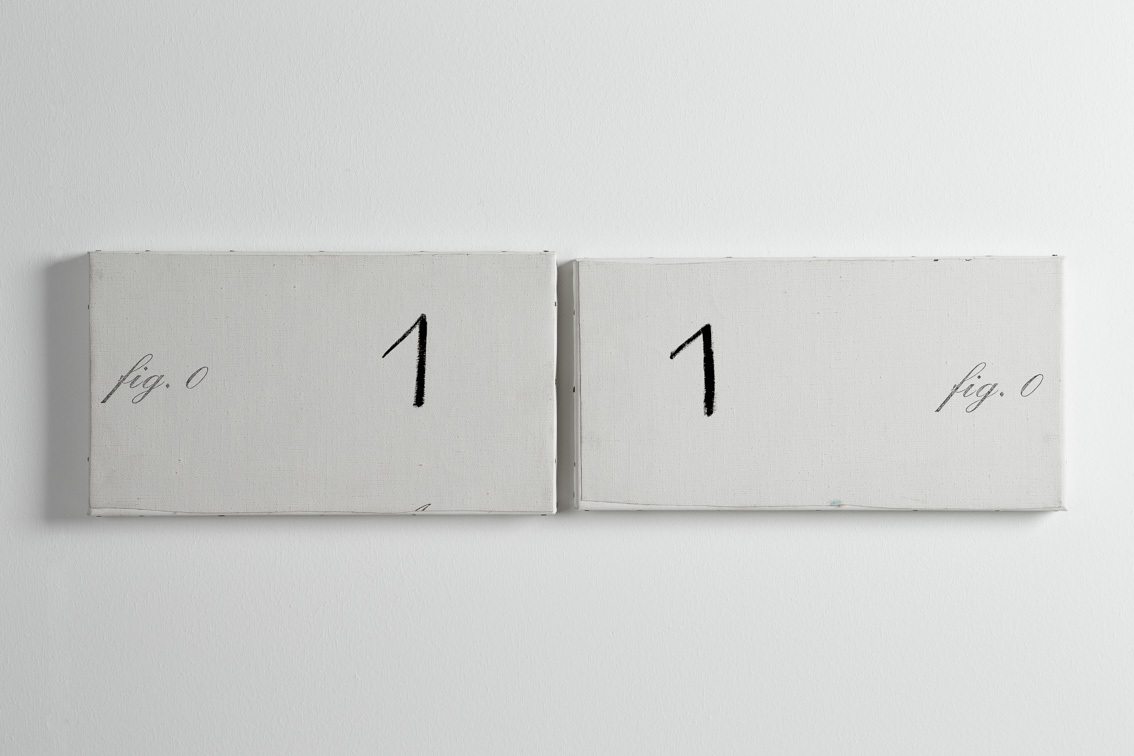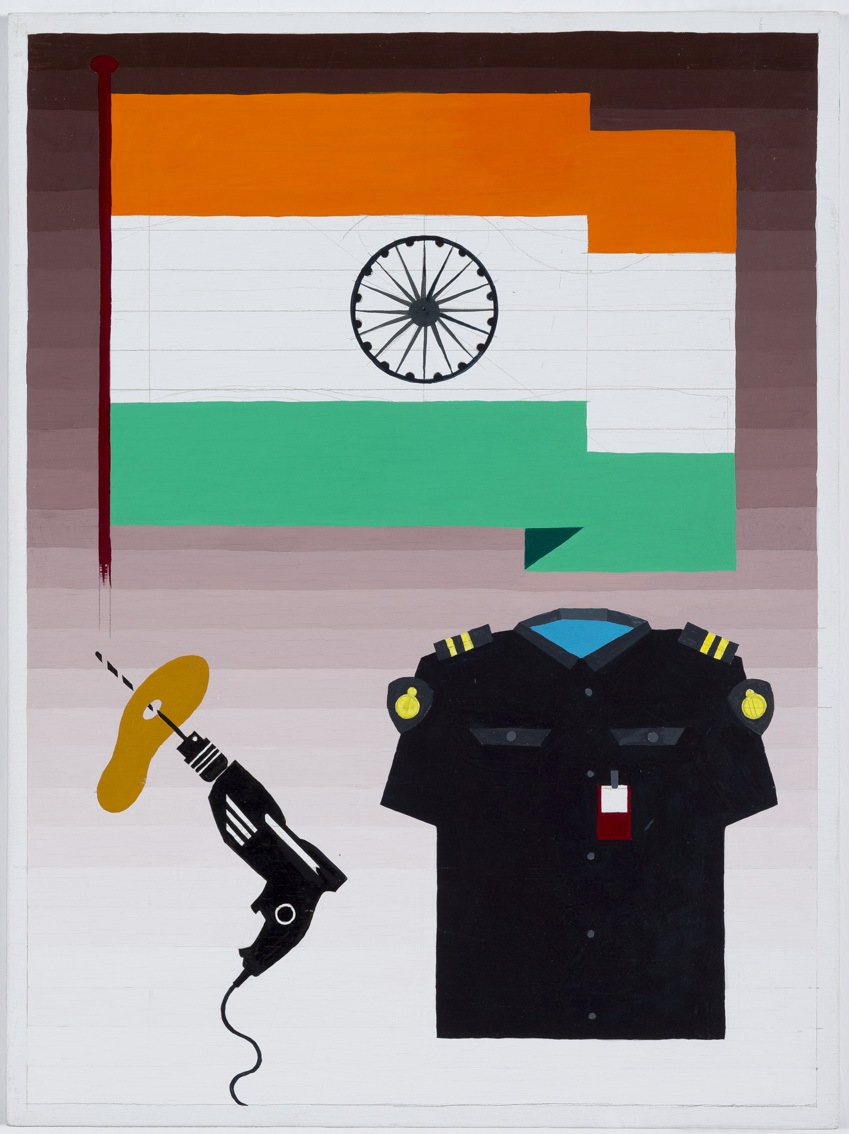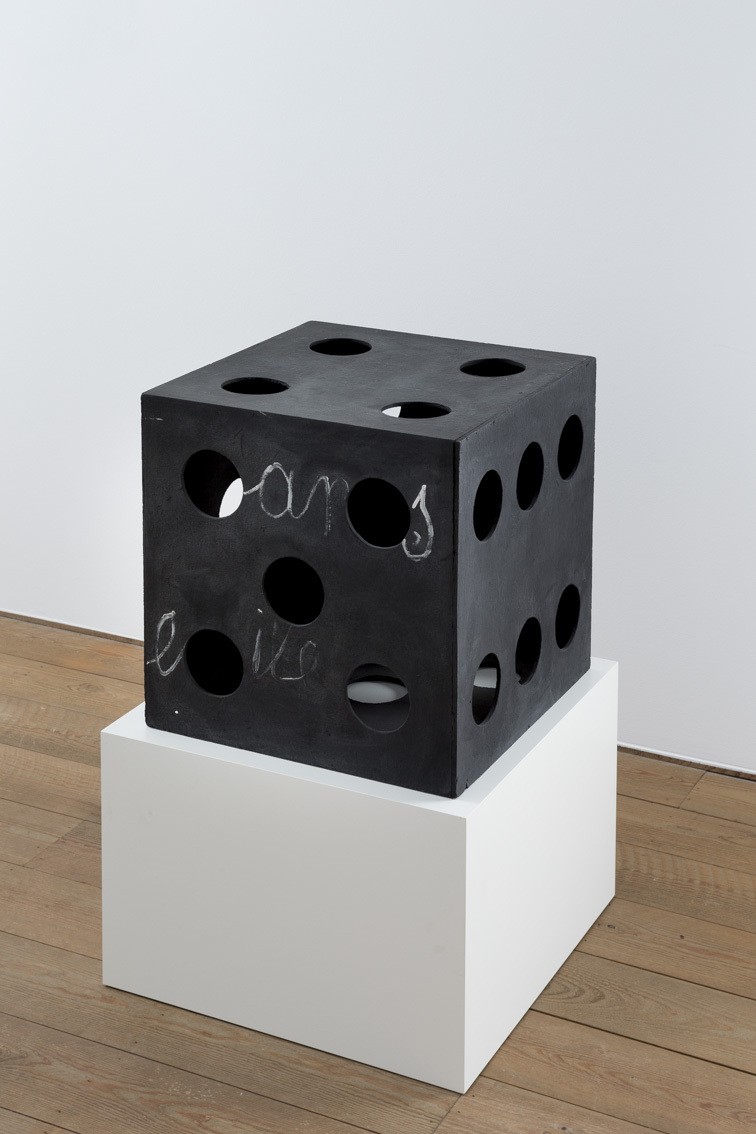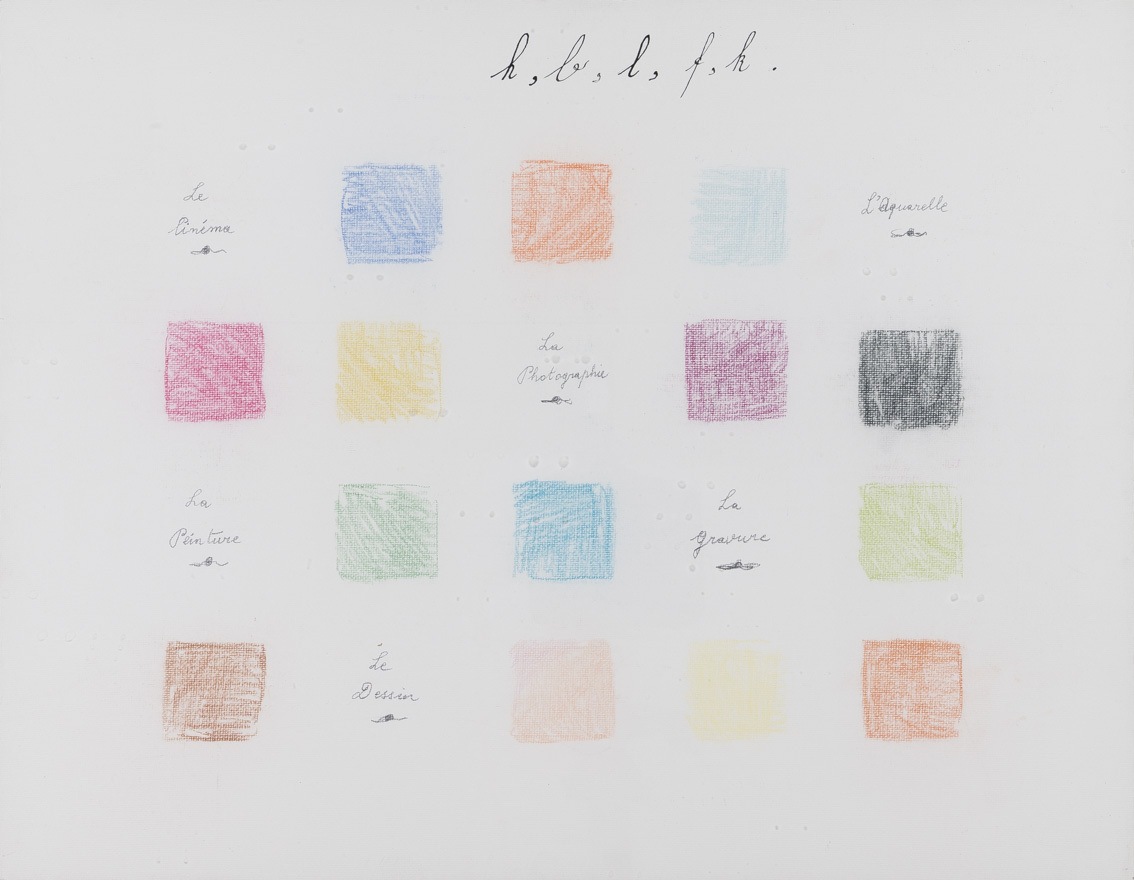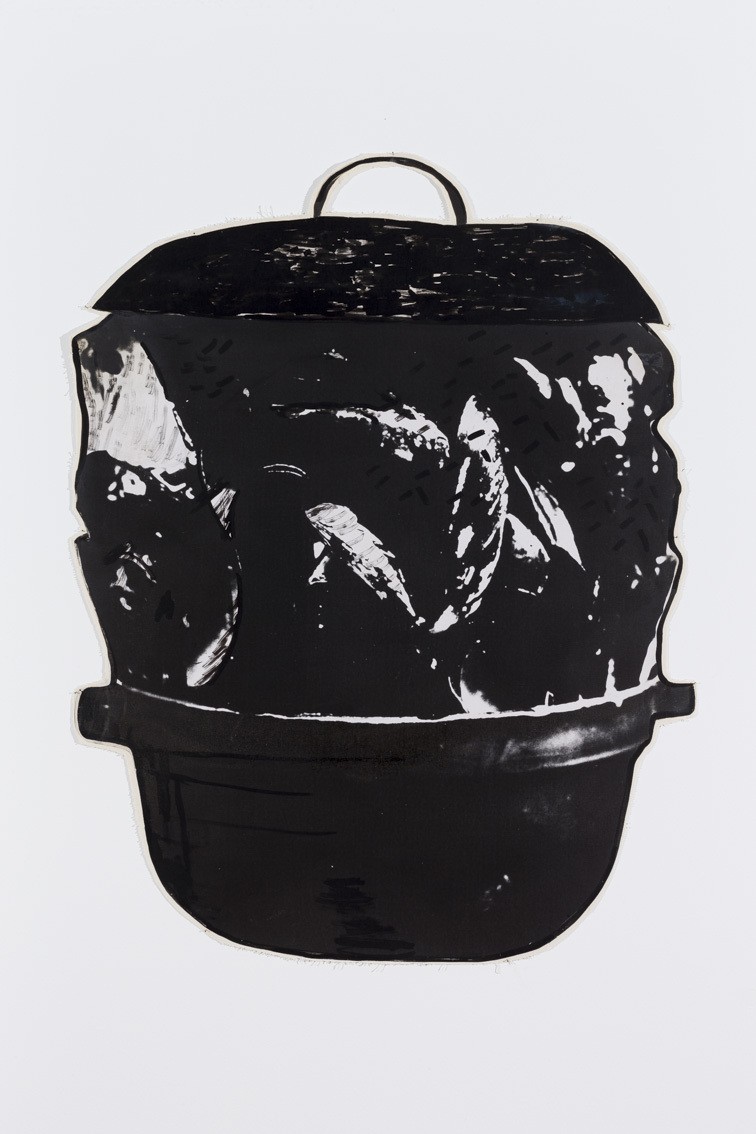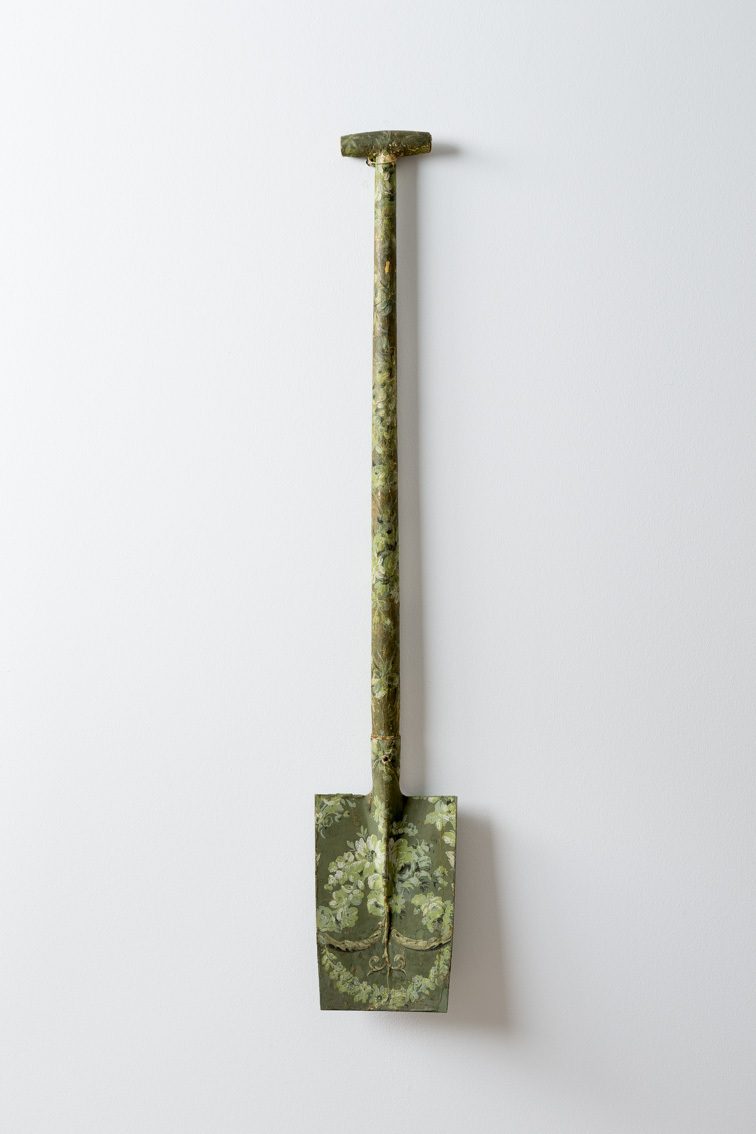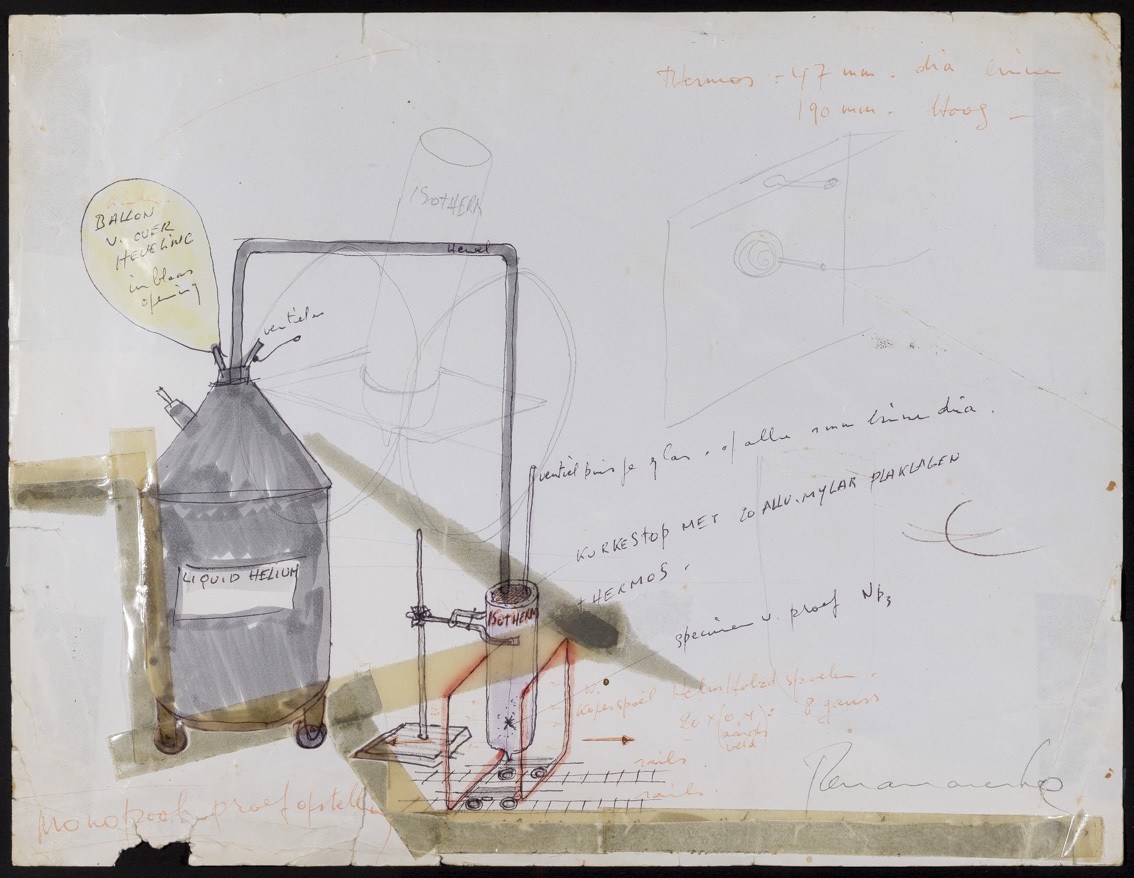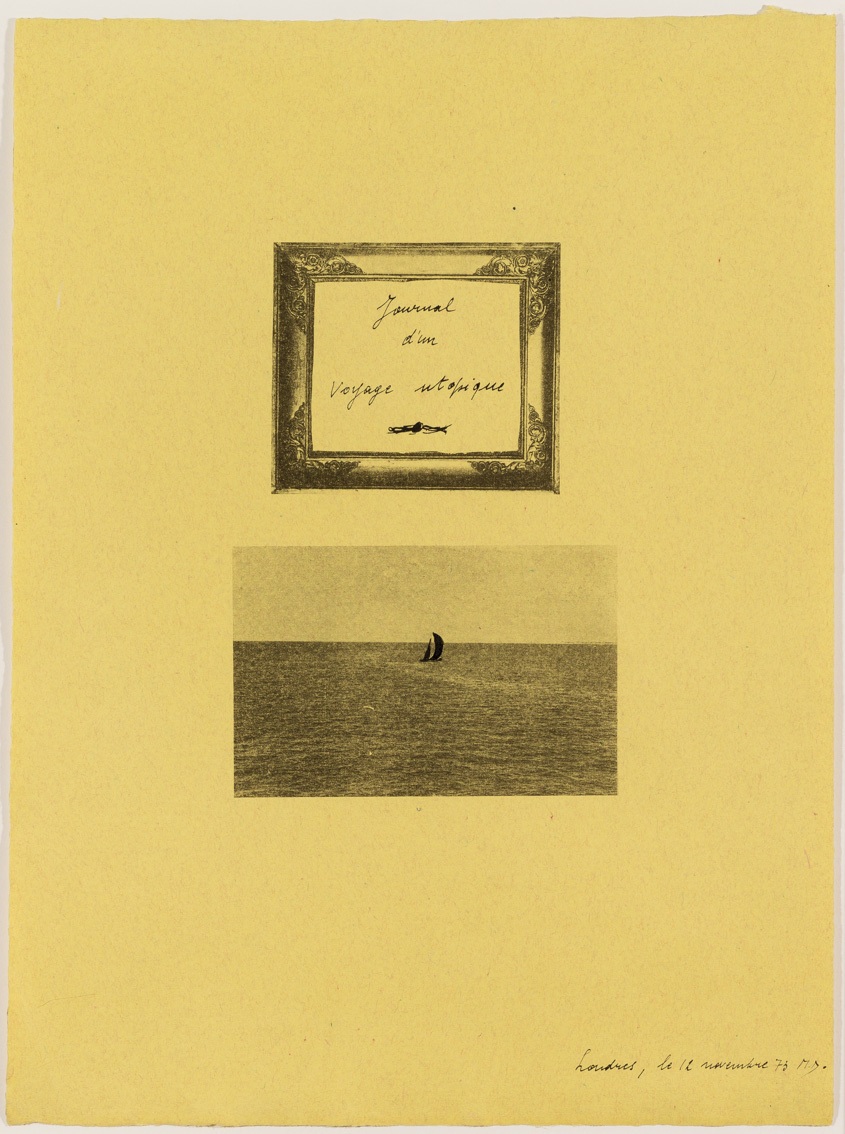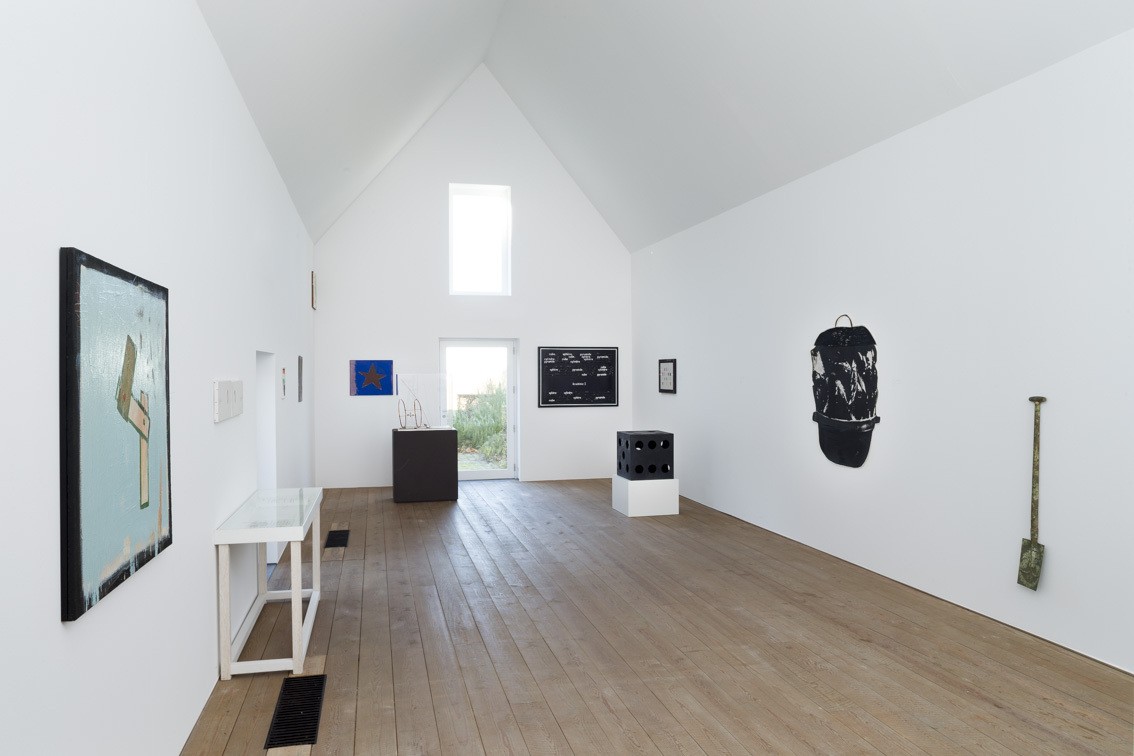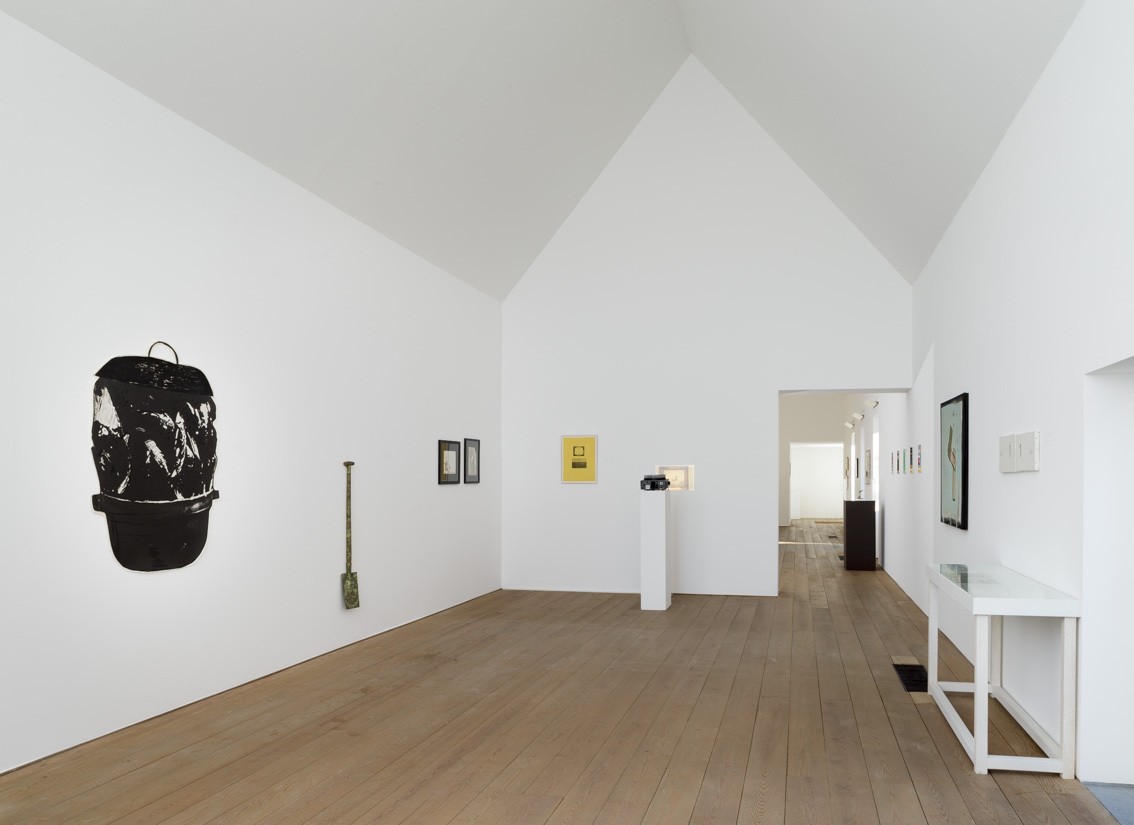Poetica_Politica
November 27, 2016 – February 25, 2017
Marcel Broodthaers, Panamarenko, Walter Swennen, Francis Alÿs, Kasper Bosmans
Poetica: early poems evolved from folk songs or from a need to retell oral epics. ‘Poetica’ is the title of two books by Aristotle.Politica: is deducted from the old Greek Politeia: ‘affairs of, for the citizens’, from which the title of Aristotle’s book: ‘Politica’.
Poetica_Politica: where art operates as a way of translating poetry and rendering affairs of, for the citizens.
Biographies
Marcel Broodthaers (1924-1976, Brussels) lived as a poet in Brussels. By his love of books, he created a commercial library. With no artistic training he turned to visual art in 1964 as an ironic gesture, with an exhibition at the Galerie Saint-Laurent in Brussels. He launched himself caustically into the art market with a brief text printed on the invitation: ‘I too wondered if I could not sell something and succeed in life… Finally the idea of inventing something insincere crossed my mind and I set to work straightaway.’ In the eleven years that remained to him he established himself, in more than seventy one-man exhibitions, as an artist of considerable influence in terms not of style or sensibility but of attitude and approach. Broodthaers regarded his art as a defence of European high cultural traditions in the face of barbarian threats and especially of western commercialism. His strategy allowed him to appropriate techniques and media from Nouveau Réalisme, Pop art, conceptual art and performance art so as to subvert them to his own aims; he emphasized the craftsmanship of his art but without any trace of academic technique or dexterity, as his work was often executed by others. At its most personal his work employed techniques associated with poetry but applied by him not only to words but to images and symbols, with a particular emphasis on irony, metonymy, tautology and synecdoche. Broodthaers associated with other artists, including Magritte and Piero Manzoni, before he became an artist himself and he adapted from their work particular devices and improbable conjunctions of images. In La Malédiction de Magritte (Magritte’s Curse), for example, he conjoined painted and printed images of a clouded blue sky. He expressed his resistance to American Pop art in sculptures such as Casserole and Closed Mussels, 1965 (collection London Tate), assembled from found materials such as eggshells, mussels and European household goods that spoke of simplicity and poverty in the face of big business, banality and mass production. From his first exhibition he conceived of the temporary installation as a medium in itself, involving not only the objects and their display but the catalogue, titles of works and the private view as an event. From 1966 he began to use film (a medium that he had used in the 1950s) and photography as an integral part of installations, which presaged later developments in conceptual art. He went on to create his own peripatetic imaginary museum, which he inaugurated in his Brussels apartment- studio in 1968 as the Museum of Modern Art, Department of Eagles, 19th-Century Section and to which he continued to add ironically titled sections. Broodthaers spent his last years in Germany and England as well as in Brussels, creating during this period a series of exhibitions collectively titled Décors, which were his definitive achievement. These temporary installations included Catalogue (1974; Brussels, Palais des Beaux-Arts), Eloge du sujet (Eulogy of the Subject, 1974; Kunstmuseum Basel), Invitation pour une exposition bourgeoise (Invitation to a Bourgeois Exhibition, 1975; Berlin, Nationalgalerie), the Privilege of Art (1975; Oxford, Museum of Modern Art) and L’ Angélus de Daumier (1975; Paris, Musée national d’Art moderne). To a greater extent than before individual works were brought together in different combinations according to the ‘laws’ of a personal syntax and poetics involving the transposition of media as well as of objects: paintings with printed inscriptions such as Painting (1973; London, Tate), a series of nine stretched canvases bearing descriptive phrases concerning various English- speaking writers; reproductions of paintings as photographs such as Mademoiselle Rivière and Monsieur Bertin (1975; London, Tate), after Ingres; hand-painted prints; films as objects; and objects as films. His work became increasingly complex and technically ambitious in all his chosen media, including paintings, drawings, films, photographs, performances, books, exhibition catalogues, prints, plastic reliefs, sound tapes, slide projections, collages, assemblages and installations. Broodthaers conceived of his inclusive medium, however, as art and culture in the broadest sense, and it is in this respect that his influence has been most lasting. (Michael Compton)
Panamarenko (1940-2019) is an exceptional and unclassifiable figure in contemporary art, who has been described as ‘one of the great creators of the end of the century’. Artist, Engineer, Poet, Physicist, Inventor and Visionary, and has for thirty years pursued a singular course of exploration of space, movement, flight, energy and the force of gravity. His work, fusing artistic and technological experiment, takes many forms: Aeroplanes, flying carpets, cars, flying saucers, submarines and birds. Spectacular structures of strange beauty, both playful and inspiring. (Panamarenko Collectief)
Selected solo shows: 2014, Panamarenko Universum, Muhka, Antwerp. 2010, Panamarenko, MODEM, Debrecen. 2009, Panamarenko, Frac Nord-Pas de Calais, Dunkerque. 2005, Retrospectieve – Flying Saucers and Devil Rowlers Motorcycle Club, Koninklijk Museum voor Schone Kunsten, Brussels. 2003, Operatie Panamarenko, Kröller-Müller Museum, Otterlo; Multiples 1966-2003, Muhka, Antwerp and Atelier Augarten, Wien. 2002, Museo Nacional Centro de Arte Reina Sofia, Madrid. 2000, Jean Tinguely Museum, Basel. 2000-2001, Orbit, Dia Foundation Center for the Arts, New York. 1998, La grande exposition des soucoupes volantes, Fondation Cartier pour l’art contemporain, Paris. 1992-1993, The Bunkamura Museum of Art, Tokyo – The National Museum of Art, Osaka – Fukuyama Museum of Art, Fukuyama – The Museum of Modern Art, Toyama – The Museum of Modern Art, Kamakura. 1991, Panamarenko. The Aeromodeller, Kunstverein Hanover. 1989, Panamarenko. Een overzicht 1965-1985, Muhka, Antwerp. 1984, Fundació Joan Miró, Barcelona. 1981, The Aeromodeller, Centre national d’art et de culture, Centre Georges Pompidou, Paris. 1978, Nationalgalerie, Staatliche Museen Preussischer Kulturbesitz, Berlijn; Rijksmuseum Kröller- Müller, Otterlo; Palais des Beaux-Arts, Brussels. 1977, Flugobjekte und Zeichnungen. Arnold Bocklin, Leonardo da Vinci, Vladimir Tatline. Flugmodelle, Plane und Fotos, Kunsthalle Basel. 1975, Atom and manpower, Kölnischer Kunstverein, Köln. 1973, Musée d’Art moderne de la Ville de Paris, ARC. 1972-1973, Automobile und Flugmaschinen, Kunstmuseum Luzern, Luzern – Städtische Kunsthalle, Düsseldorf – Württembergischer Kunstverein Stuttgart. Selected group exhibitions: 2016, Inspiratie, O.M. Koninklijke Academie voor Schone Kunsten, Antwerpen; Magie und Macht – Von fliegenden Teppichen und Drohnen, MARTa, Herford. 2015, ARStronomy, La Casa Encendida, Madrid. 2014, Passions Secrètes, Collections Privées Flamandes, Tripostal, Lille; De Vierkantigste Rechthoek, KAdE, Amersfoort; Constellations, Frac Nord-Pas de Calais, Dunkerque; Spuren der Moderne, Kunstmuseum Wolfsburg, Wolfsburg. 2013, Visionen- Atmosphären der Veränderung, MARTa, Herford; Wanderlust. A Never Ending Journey to the Other Side of the Hill (cur. Hans De Wolf & Yun Ik), Gwangju Museum of Art, South-Korea. 2012, S.F. [Art, Science & Fiction], MAC’s – Grand Hornu; ENSEMBLEMATIC, S.M.A.K., Ghent. 2010, Der Offene Garten, Kunsthalle Lingen Kunstverein, Germany; The Science of Imagination, Ludwig Museum – Museum of Contemporary Art, Palace of Arts, Budapest; Ich weiß gar nicht, was Kunst ist – Einblicke in eine private Sammlung, MARTa, Herford. 2003, Wings of Art – Motiv Flugzeug, Kunsthalle Darmstadt; Defying Gravity – Contemporary Art and Flight, North Carolina Museum of Art, Raleigh, NC. 2002, Sydney Biennale 2002, Sydney. 2000, Useless Science, Museum of Modern Art, New York; Voici, Paleis voor Schone Kunsten, Brussels. 1999, Les Champs de la Sculpture, Champs Elysées, Paris; Scotch Gambit, Museum Dhondt-Dhaenens, Deurle. 1998, Landschaft. Die Spur des Sublimen, Kunsthalle zu Kiel; Kunstraum Innsbruck; Kunstmuseum Esbjerg, Denmark. 1997, La Biennale di Venezia 47, Venice. 1996, Ars Aevi 2000, Centro per l’Arte Contemporanea Luigi Pecci, Prato; Comme un oiseau, Fondation Cartier pour l’Art Contemporain, Paris. 1995, Les Constructions du Ciel 1900-1958 & Panamarenko, Fondation pour l’Architecture, Brussels. 1992, Documenta 9, Kassel. 1991, Irony by vision: René Magritte, Marcel Broodthaers, Panamarenko, Jan Fabre. Tokyo. 1990, Artisti (della Fiandra), Palazzo Sagredo, Biennale di Venezia, Venice. 1981, Dia Chelsea ’00-‘001, Dia Chelsea, New York. 1977, Documenta 6, Kassel; Europe in the Seventies: Aspects of Recent Art, The Art Institute of Chicago US. 1976, La Biennale di Venezia 1976 – International Events, Venice. 1975 Function of Drawing, Kröller-Müller Museum, Otterlo. 1972, Documenta 5, Kassel. 1970, Information, Museum of Modern Art, New York.
Walter Swennen (b. 1946, Brussels) is a painter. Just like others in his generation he approaches and explores the medium anew by applying principles from other disciplines. After his early activity as a poet in the 1960s, and in the aftermath of the visually reductive conceptual and fundamental art, Swennen decided in the 1980s to examine the lyrical possibilities of painting. The oeuvre he then rapidly developed was explicitly not characterised by the spontaneous or heroic visual language of his expressionist contemporaries. It becomes obvious in retrospect that Swennen is engaged in a steady reconnaissance of the specific problems of painting, with a preference for subtle forms of rebellion, deviation and relativising: such as the marginal, the nonsensical, understatement, the anticlimax and the tragicomical. Whoever looks beyond the seemingly naïve execution of his work discovers in addition sources of inspiration as varied as comic strips, world literature and philosophy, bilingual dictionaries, advertisements, and (his) children’s drawings. Given that painting is in essence mute, Swennen demands at least as much attention to the complex material background (which remains unknowable) as to the familiar figure in the foreground.
Major solo exhibitions: 2013, ‘Continuer’ Culturgest, Lisbon – where curator Miguel Wandschneider has spent eighteen years researching Swennen’s work – and focuses on the artist’s early career. Particular attention is paid to the early 1980s, when Swennen turned his back on poetry and defined himself solely as a painter. 2013-14, So Far So Good, WIELS, Brussels – reflects Swennen’s characteristically philosophical attitude. His aversion to all kinds of fashion and authority goes with an impressive, uncompromising body of work that has found its unique place amongst artists. Through the works the exhibition explores two questions which have spurred Swennen on over the past three decades, however much his answers may have varied over that period: what to paint? And how? WIELS aims to increase awareness of Walter Swennen’s work, at both a national and international level, and to accord it the attention it merits. 2012, Garibaldi Slept Here, Kunstverein Freiburg. 2008, How To Paint A Horse, Cultuurcentrum Strombeek and De Garage, Mechelen. WIELS, Contemporary Art Centre, Brussels.
Francis Alÿs (b. 1959, Antwerp) studied architecture before moving to Mexico City in 1986, where he lives and works. Through out his multifaceted practice, Francis Alÿs consistently directs his distinct poetic and imaginative sensibility toward anthropological and geopolitical concerns centered around observations of, and engagements with, everyday life, which the artist himself has described as ‘a sort of discursive argument composed of episodes, metaphors, or parables’. A major solo museum exhibition, A Story of Negotiation, featuring the artist’s three projects Don’t Cross the Bridge Before You Get to the River, Tornado, and REEL-UNREEL has been presented at the Museo Tamayo Arte Contemporáneo in Mexico City, Museo de Arte Latinoamericano de Buenos Aires (MALBA) – Fundación Costantini in Buenos Aires (both 2015) and the Museo Nacional de Bellas Artes de la Habana in Havana (2016). It will continue to tour later this year to the Art Gallery of Ontario in Toronto. Alÿs’s ongoing project Fabiola is currently on view at The Menil Collection in Houston, Texas (through January 28, 2018). In 2014, Alÿs’s video REEL-UNREEL was on view alongside related drawings, paintings, and research materials at Museo d’Arte Contemporanea Donna Regina Napoli, Naples. The exhibition traveled later in the year to the Centre for Contemporary Art Ujazdowski Castle, Warsaw. REEL- UNREEL was produced in 2012 for documenta 13, where a selection of paintings was installed in a former bakery in Kassel’s city center and the video was screened at a satellite venue in Kabul. The artist’s work was the subject of a major survey, A Story of Deception, which was on view from 2010 to 2011 at Tate Modern, London; WIELS, Centre of Contemporary Art, Brussels and The Museum of Modern Art, New York and MoMA PS1, Long Island City, New York. Over the past decade, he has had several solo exhibitions at prominent venues, including the Museum of Contemporary Art, Tokyo (traveled to the Hiroshima City Museum of Contemporary Art, both 2013); Irish Museum of Modern Art, Dublin (2010); The Renaissance Society at the University of Chicago (2008); Hammer Museum, Los Angeles (2007); Hirshhorn Museum and Sculpture Garden, Washington, D.C.; and Portikus, Frankfurt (both 2006).
Kasper Bosmans (b. 1990, Lommel) is a shrewd observer of the ways in which images can teeter on the edge of nature and fiction, or art and craft. With an intuitive anthropological approach, he looks towards the remnants of local traditions and mythological iconography in contemporary life. Concerned with an associative beauty produced by play, Bosmans cuts across performance, painting, drawing, and sculptural installations made up of various components, such as milk, sand or marble – means through which he explores both functional and decorative forms, and evokes subtle correspondences between them. Solo exhibitions: 2016, Decorations, Witte de With, Rotterdam; Specimen Days, Stedelijk Museum voor Actuele Kunst, Ghent; Cintamani Weavings, Art Center Centrale, Brussels; Loot, Soil, and Cleanliness, CIAP, Hasselt; 2015, Little Cherry Virus, Pakt, Amsterdam. Group exhibitions: 2015, Correspondence, with Rafaella Crispino, Unosunove, Rome; Yesterday was different with Marthe Ramm Fortun, KOMPLOT, Brussels; Des hôtes: a foreigner, a human, an unexpected visitor, Spring Workshop, Aberdeen; Un-Scene III, WIELS, Brussels; 2014, Coming People, S.M.A.K., Ghent.
Photo: www.bartvanleuven.com
A catalogue of the exhibition will be published.
